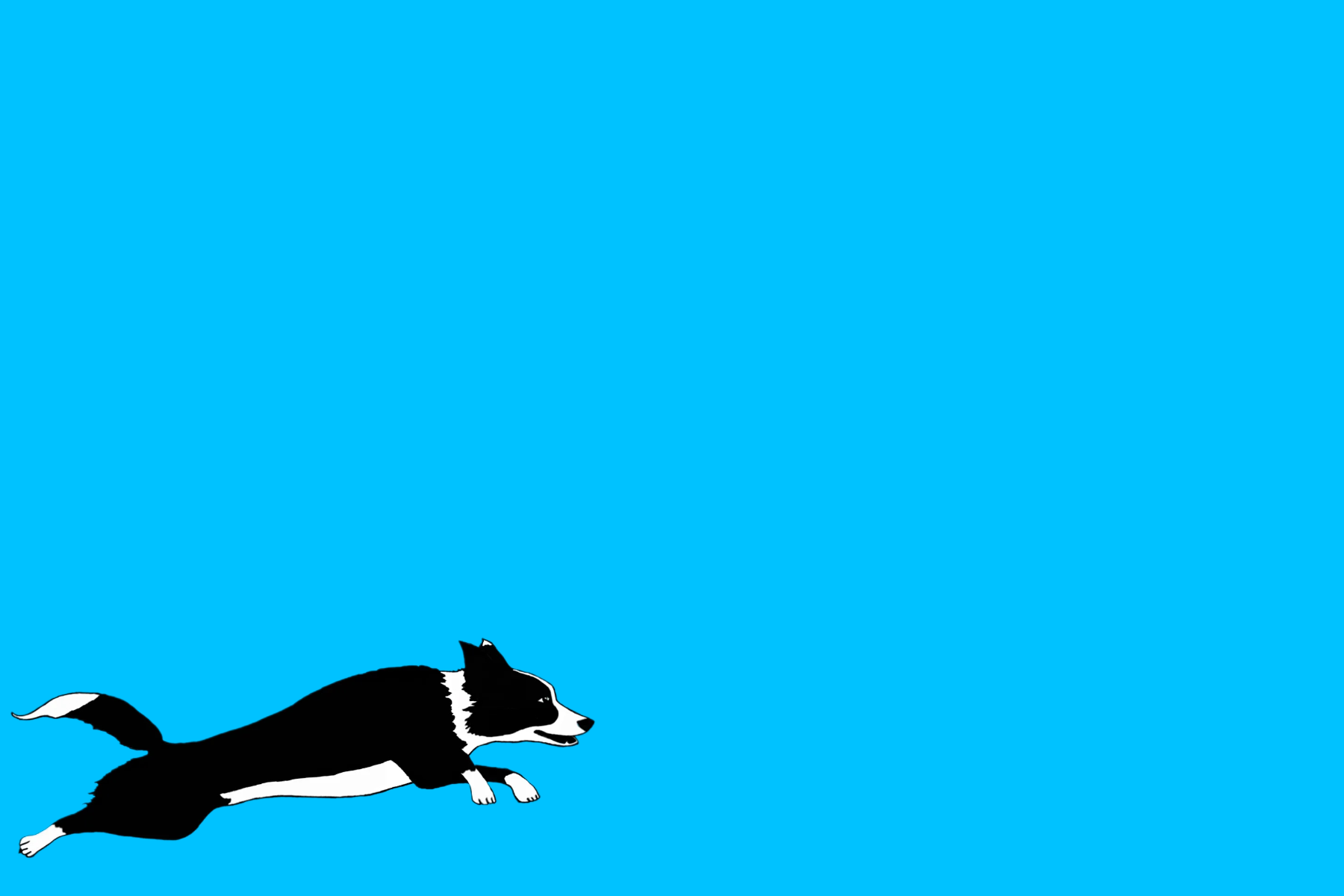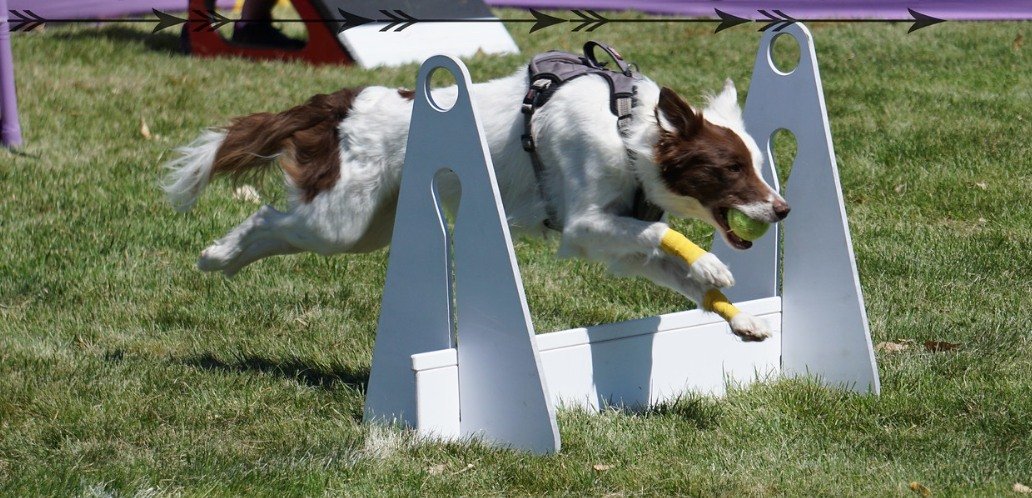
About Border Collies
History
The Border Collie developed centuries ago in the border country between Scotland and England as a herding dog to help manage and move the large flocks of sheep that grazed the vast hilly pastures of England, Scotland, Ireland, and Wales. One of their most notable traits is an outstanding and pronounced gathering or fetching instinct – a natural desire to guide the direction of stock to a handler. The breed’s “eye,” an intense stare accompanied by a crouching, stalking movement, is very effective at moving stock without the need to get close, saving energy and preventing potential injury.
Physical Appearance
The fact that Border Collies have been bred for their working ability on a variety of stock means that they have much more variability in physical appearance than most breeds, who are often bred to meet an arbitrary physical “standard” versus effectiveness of purpose. Border Collies range from under 30 to over 60 pounds, with varying builds, and can have a rough (long), medium, smooth (short), or even a curly coat. In addition to the most commonly recognized classic black with white blaze, collar, feet, and tip of tail, Border Collies can also be red, blue, sable, brindle, or yellow with white, blue or red merle, black and tan, or even be predominantly white or black.
A large variety or markings are seen in the breed as well, including white or split (half white/half black) faces, tricolor (black and white with brown points), and freckling or ticking. Eyes can be brown, blue, or gold, and ears can stand straight up, flop all the way down, or do anything and everything in between! For a closer look at the variety of appearances, visit the Border Collie Museum’s Color pages: Border Collie Museum
Temperament & Charcteristics
Border Collies tend to be attentive and desire to engage with people. They are inquisitive, sensitive, quick, and eager to learn. Athletic and agile, possessing incredible stamina, Border Collies require vigorous exercise daily. In addition, they have a strong work ethic and an unsurpassed ability to focus, especially visually. Their incredible observational skills and predisposition for learning verbal cues have resulted in their being touted as the “smartest” of all dog breeds.
The unique temperament and abilities of the Border Collie are, however, a double-edged sword. Thanks to their reputation as an intelligent breed and their demonstrated capabilities, Border Collies are increasing in popularity. This has led to the breed moving from farms and ranches to suburbia and non-working environments, bringing with it challenges in adapting to life as companion animals. The very qualities necessary for performing the jobs they have been bred to do are the same qualities that can make the BC a troublesome and difficult pet for many families. These dogs were built for long days of unending movement in hilly terrain, working in cooperation with a shepherd to move stock over vast distances. It should come as no surprise, then, that they are high-energy dogs that need direction on where to focus their keen minds and endless energy.
Border Collies tend to be more aware of personal space, making them sensitive to body language and handling. They can also be sensitive to loud noises like thunder and fireworks, and they will often react to sudden changes in a quiet environment.
All herding breeds have a desire to control movement, and this translates to a Border Collie’s interest and excitement with moving things—be it stock, cars, bicycles, running children, water coming out of a sprinkler, or a vacuum cleaner.
Given these innate tendencies, Border Collies are not always the best breed for families with small children or cats. BCs with a lot of “eye” may exhibit bizarre behaviors such as circling, staring, stalking, and freezing up. Their human-oriented nature means they don’t do very well when left alone for long periods, and their renowned endurance means that a 1- to 2-mile run is barely a warm-up for most members of the breed. Border Collies require substantial daily stimulation: mental, emotional, and physical. They need guidance and direction, and if they are not given any, they will find their own job: chasing cars, barking, learning how to open cabinets and doors, or redecorating your living room in less-than-lovely ways. A bored, under-exercised, and under-stimulated BC often exhibits neurotic, obsessive, and destructive behaviors, none of which are particularly pleasant for the dog or the human. The fact that Border Collies require a large amount of time, energy, and commitment from their owners who are not familiar with the breed is one of the main reasons they end up in shelters. This is why we strive to find the perfect home for each of the dogs in our care. Every dog is unique and just like any breed, we see a wide range of personalities, daily exercise requirements, and social temperaments. Some dogs are social butterflies-drawn to people and children. While others may prefer to live as a single dog home away from the hubbub of suburban life.
As Pets
While many Border Collies would certainly love to run the hills herding all day, they can adjust well to life as pets if given the right circumstances. In an active and engaged home that involves their pets extensively, BCs can make wonderful, entertaining, and delightful companions. Their long history of being bred for human-partnered work translates to excellence in canine-human partnership sports such as agility, obedience, frisbee, flyball, freestyle, and nose work. They can also sometimes be great candidates for Search and Rescue or therapy work. Their athleticism makes them ideal active outdoor adventure companions for runners, hikers, bikers, or skiers.
The common misconception is that the sole requirement for having a Border Collie is “room to run,” and that more property, a bigger yard, or a “farm” is the answer. That is simply not the case. What a Border Collie needs is YOU—not being left alone in a yard where, like many social dogs, they become lonely and unhappy, and are unlikely to self-exercise. With a committed owner who understands and can meet the needs of the breed, BCs can thrive in all kinds of environments, even in cities or apartments without yards.
That being said, there are exceptions to the norm. Mellow BCs do exist, and many BC mixes or middle-aged BCs tend to decrease in intensity, becoming a little less demanding.
Health Issues
While the Border Collie is generally a healthy breed compared to some, one of the most notable potential health issues is a mutation in the MDR1 gene. This mutation, present in many herding breeds, results in multi-drug sensitivity to several commonly administered medications, which can prove fatal. The only way to know if a dog has this mutated gene is through testing.
Some dog DNA Companies have the option to test for MDR1 gene as one of their health screens. But you can also ask your veterinarian about the best way to test for you and your dog.
If the idea of a high-energy, super-interactive, busy-body canine companion appeals to you, continue to our adoption process. If you admire the breed but realize you’re not ready, there are numerous ways you can still help make an impact.
Dog Sports
Here are some examples of our WBCR Alumni showing that Rescues can excel in dog sports too!
-

Agility
-

Disc
-

Dock Dog
-

Flyball
-

Herding
-

Search & Rescue
-

Adopting a rescue dog can be an exciting addition to your family, and it also opens a foster home to save another life. Find out more about our approval process and fill out our application.
-
WBCR is a foster-based rescue, which means all of our dogs are fostered in loving homes. Each foster home saves the life of a shelter dog, but it also saves the life of another dog by freeing up space at the shelter for a new dog in need. Learn more about fostering or submit a foster application.






